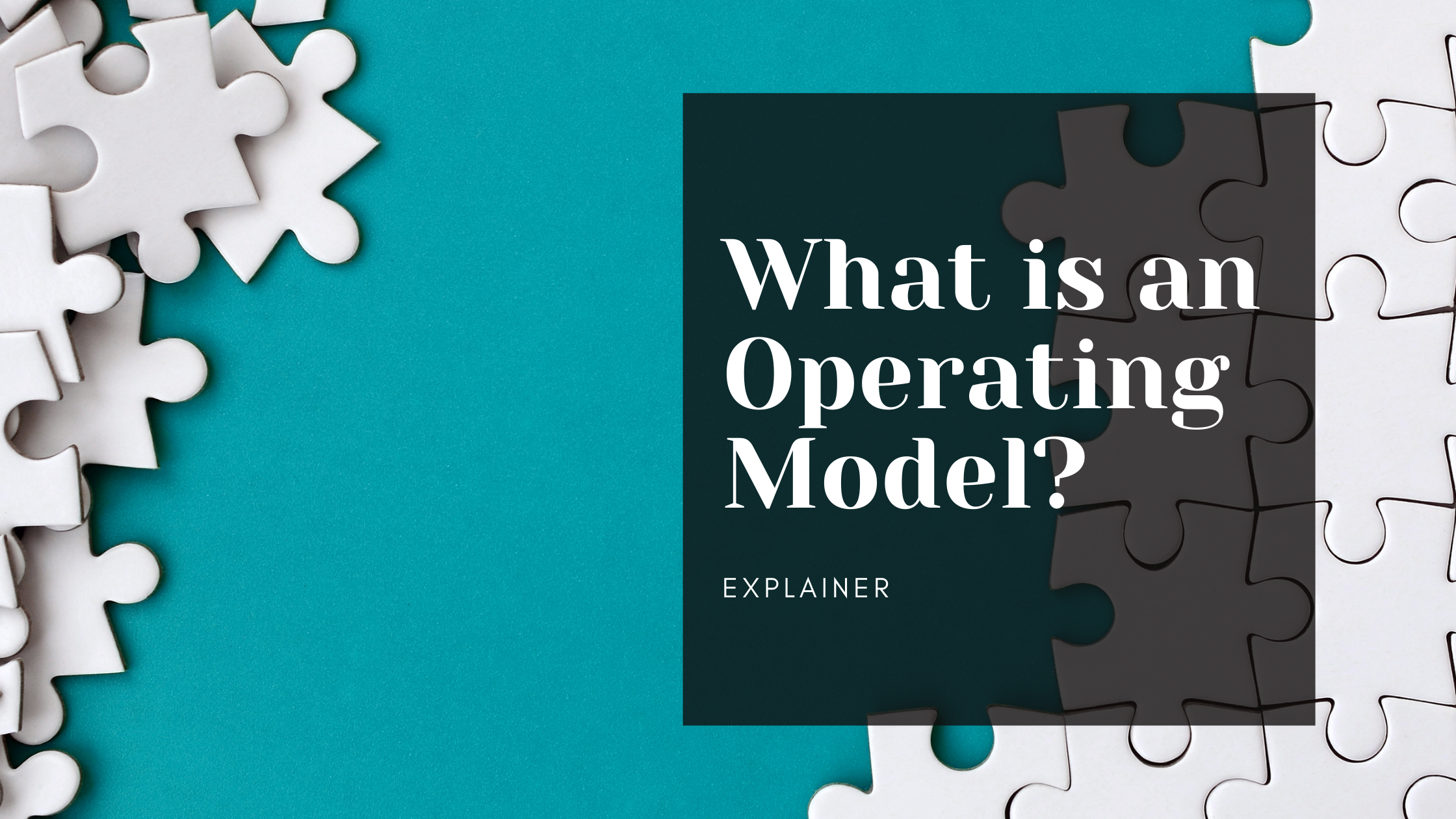
“How can we successfully execute our strategic objectives?”
It’s a question many public sector executives ask themselves as they face pressures to transform what their teams do in a constantly evolving environment. As illustrated by Deloitte’s 2021 Government Trends, change seems like the only constant, whether it’s because of the Machinery of Government, the need to do more with the same, the expectation of providing seamless service delivery to customers, the need to accelerate digitisation, or the increasing requirement to sustain public trust.
Luckily, there’s a proven approach and methodology that can help simplify the complexity and bridge the gap between strategic ambitions and results. It’s called an Operating Model. According to Accenture Strategy Research, more than 80% of executives agree that advanced operating models are an enabler of strategic growth. Yet only 22% say their organisation’s operating model is helping them put strategic growth initiatives into action.
In this post, we’ll define what an Operating Model is, outline why it is important, and provide 5 steps for how you can start to develop your Operating Model within your organisation.
“Organisations that adopt more dynamic operating models respond faster to changing priorities, better meet the needs of people they serve, and engage and empower employees.” (Thodey, Independent Review of the APS: Priorities for change, 2019).
What is an Operating Model?
A useful analogy to help explain the concept of an Operating Model is holistic health. One of the disadvantages of western medicine is the siloed approach to health, which looks at the body in sections of individual symptoms and pieces rather than the whole system it really is. On the other hand, holistic health is about caring for the whole person; body, mind, and spirit. It recognises that all these aspects can affect your overall health, and being unwell in one aspect affects you in others.
The same thinking can be applied to the health of an organisation. You might have the best shiny new technology in the world, but if it supports services the customers don’t want, or it's operated by people who don’t have the necessary skills, then the organisation is unlikely to be successful.
This is why an Operating Model is NOT a few boxes and lines on an organisation chart. A common misconception by many. Instead, an Operating Model is a visual, holistic representation that shows the combination of elements (such as people, processes and systems) required to deliver products and services to customers.
An Operating Model decomposes organisations into several building blocks, all of which are highly interdependent (see below).
This decomposition enables a holistic approach to improving the success of an organisation because it provides transparency regarding subtle interactions between each building block that could otherwise lead to unintended consequences when making changes.
As stated in the Thodey Report 2019, “research into MOG changes suggests they are frequently enacted but poorly implemented..and highly disruptive.” There have been more than 200 MOG changes in the last 20 years, most of which have specifically focused on changes to the organisational structure rather than taking a more holistic approach.
Why is an Operating Model important?
An Operating Model is important because:
It provides clarity on how an organisation provides value to customers
It helps to determine whether change is required
It provides a mechanism for successfully executing change
It provides clarity on how an organisation provides value to customers
Clarity is achieved by answering the following questions.
-
Who are our customers?
..through which channels and relationships do we serve them?
..providing what value proposition?
-
..undertaking what activities?
..focusing where to deliver greatest value?
-
requiring what roles?
...what skills?
...and what performance measures?
-
..with what functional accountabilities?
..and with what organisation design?
..retaining what activities in-house?
-
..with assets based in which location(s)?
-
..capturing what information and data?
-
..engaging and managing which stakeholders?
..partnering with who to deliver our services?
-
..with what IT applications required to support our processes?
..and determining bespoke versus enterprise applications..
-
..using what processes and meetings to manage and oversee performance?
..with what means to measure performance?
-
..adhering to which cultural norms and behaviours?
Find out more about our BeHOLISTIC™ Framework
This creates a blueprint to bridge the gap between the strategic vision and what individuals and teams should be doing in their roles, helping them to answer “what does the strategy mean for me?” While strategy engages 10% of the organisation, operating models engage the remaining 90%.
“At the end of our monthly executive, I asked the leadership team to articulate the strategy in their own words. Each response was different. ”
It helps to determine whether change is required.
In some cases, such as a new strategy, it’s obvious that change needs to happen. In other instances, it may be less clear. Typical symptoms that suggest change is required include:
Low people engagement scores from the PMES survey
Failure to execute strategic ambitions
Frustrated customers and stakeholders
Poor relationships between individuals and teams
Cultural challenges
An inability to prioritise work
A clearly defined Operating Model provides the opportunity to identify areas of concern more easily, such as duplication, fragmentation of systems, and areas of high cost. This clarity provides a common understanding of the business and current challenges to then act as the foundation for any change in the future.
It provides a mechanism for successfully executing change.
Providing a consolidated, holistic view of all business activity, incorporating customer, process, people and systems, and their interdependencies enables public sector executives to make informed decisions regarding how they change the organisation.
“Vision without action is a daydream. Action without vision is a nightmare.”
They can confidently decide what the business will and will not do in the future because they can visualise the impact of their decisions. They can then identify what initiatives are required to reach their end state and drop those which don’t. They can also clearly communicate the future to their teams and wider stakeholder groups, helping to manage the impacts of change.
“I asked my direct reports to align their projects to the strategy. It was an eye-opener when most of them did not fit.”
5 steps for developing an Operating Model
Developing an Operating Model isn’t easy, but it is possible if you follow these essential steps.
-
Gather data through interviews, workshops, and documentation, to document the current state and assess what’s working well and what could be improved.
-
You may find that having greater rigour around documenting the current state is all that’s required. Or you may uncover some major pain points that are constraining you from achieving your strategic objectives. If the latter is true, you need to be able to articulate the rationale for change, including the consequences of not changing, to then engage the workforce in the right way.
-
Design principles set the boundaries for what the future state will and will not be. They provide an objective means of assessing different options for the Operating Model.
-
Mobilise the right people with the right skills to facilitate workshops, working on critical elements of your future Operating Model. Workshops can focus on different elements of the Operating Model while visualising the interdependencies as a whole. The design principles should be used to guide the discussions.
-
Define the initiatives required to move you to the future state, each with a supporting business case. Assign accountability for each initiative, and agree on governance for the transformation program. Ensure all of this is supported through extensive change management and communications for your workforce to buy into the changes being made.
For examples of Operating Models within the public sector, please click here.
Do you need to work on your Operating Model?
Several questions can be asked to determine whether you need to work on your Operating Model.
Do you have the right people with the right skills to execute your strategic objectives?
Do your teams have a culture of accountability? Do they collaborate as effectively as you would like (internally and externally)?
Are you able to consistently meet the needs and priorities of key stakeholders and customers?
Are you set up to successfully withstand the impacts from an evolving environment (e.g., Machinery Of Government)?
Are your teams able to quickly prioritise their work and avoid dropping the ball on important tasks?
Do your people understand what the strategy means for them operationally? Are you able to easily communicate what will change?
Do you consistently achieve high scores from employee engagement surveys?
Are you able to consistently execute your strategic objectives, achieving outcomes in the way you originally intended?
If the answer to any of these questions is No, then you should consider working on your Operating Model.
Our team has global experience in designing and implementing Operating Models with major organisations.
Listen to our podcast
“Thriving in Uncertainty”, spotlights inspirational leaders from across the public sector who have gotten comfortable in ambiguity as they share personal experiences throughout their careers. 25-minute episodes drop weekly and be available to listen to from our website or across Apple podcasts and Spotify, helping you gain fresh and unique perspectives at a time that’s most convenient for you.
Elevate by CorbettPrice
In a sector where change is constant, learning has to be, too.
Elevate by CorbettPrice is a comprehensive range of professional development training designed for all leaders and their teams in the public sector, regardless of their role or jurisdiction. Our courses are led by CorbettPrice consultants with extensive experience in helping public sector organisations solve and overcome problems to transform effectively.




